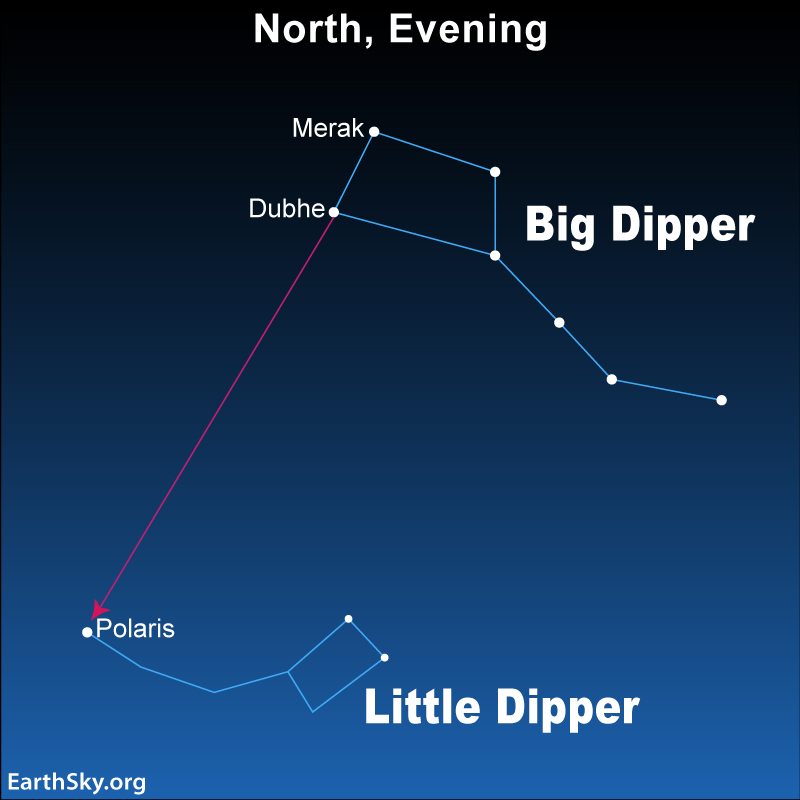
The Big and Little Dipper
The Big Dipper is one of the easiest star patterns to locate in Earth’s sky. It’s visible just about every clear night in the Northern Hemisphere, looking like a big dot-to-dot of a kitchen ladle. As Earth spins, the Big Dipper and its sky neighbor, the Little Dipper, rotate around the North Star, also known as Polaris.
From the northern part of the Northern Hemisphere, the Big and Little Dippers are in the sky continuously. In fact, they are always above your horizon, circling endlessly around Polaris. So given an unobstructed horizon, latitudes north of the 35th parallel (the approximate location of the Mediterranean Sea and Tennessee’s southern border) can expect to see the Big Dipper at any hour of the night every day of the year.
As for the Little Dipper, it’s circumpolar – always above the horizon – as far south as the Tropic of Cancer (23.5 degrees north latitude).
If you can spot the Big Dipper, then you’re on your way to finding the Little Dipper and the North Star, Polaris, too.
Last chance to get a moon phase calendar! Only a few left. On sale now.
The Big Dipper rotates around Polaris every night and changes by season
Just remember the old saying spring up and fall down. So on spring and summer evenings in the Northern Hemisphere, the Big Dipper shines at its highest in the evening sky. Then, on autumn and winter evenings, the Big Dipper sweeps closer to the horizon.
The Big Dipper rotates around the North Star or Polaris during the different seasons. Do you ever wonder why you can see the same stars night after night? Did you ever wonder why when you see a double rainbow, the rainbow on the top has the colors in reverse? pic.twitter.com/dTSOy7kAab
— Samantha Burns (@SamanthaRose369) November 27, 2022
Here’s how to find Polaris and the Little Dipper
Notice that the Big Dipper has two parts, a bowl and a handle. Next, look for the two outer stars in the bowl of the Big Dipper. They are called Dubhe and Merak, and they’re known as The Pointers. An imaginary line drawn between them points to Polaris, the North Star. And, once you have Polaris, you can find the Little Dipper, too … if your sky is dark enough.
That’s because Polaris marks the end of the Little Dipper’s Handle.
So why isn’t the Little Dipper as easy to pick out as the Big Dipper? That’s because the stars between Polaris and the outer bowl stars – Kochab and Pherkad – are rather dim. As a matter of fact, you’ll need a dark country sky to see all seven of the Little Dipper’s stars.
The Big and Litter Dipper are not constellations
Also, the Big Dipper isn’t a constellation. It’s an asterism, or noticeable pattern of stars. The Big Dipper is a clipped version of the constellation Ursa Major the Greater Bear. And the stars of the Big Dipper outline the Bear’s tail and hindquarters.
The Little Dipper is also an asterism, these stars belonging to the constellation Ursa Minor the Little Bear.
The Big Dipper will change over time
Astronomers sometimes speak of the fixed stars, but know the stars aren’t truly fixed. Stars move in space. Thus the star patterns that we see today as the Big and Little Dippers will, slowly but surely, drift apart over time.
But even 25,000 years from now, the Big Dipper pattern will look nearly the same as it does today. Astronomers have found that the stars of the Big Dipper (excepting the pointer star, Dubhe, and the handle star, Alkaid) belong to an association of stars known as the Ursa Major Moving Cluster. These stars, loosely bound by gravity, drift in the same direction in space.
In 100,000 years, this pattern of Big Dipper stars (minus Dubhe and Alkaid) will appear much as it does today! But there will be some differences, as illustrated in the video below:
Star lore behind the Big and Little Dipper
In the star lore of the Mi’kmaq nation in northern Canada, the Big Dipper is also associated with a bear, but with a twist. The Mi’kmaq see the Big Dipper bowl as a Celestial Bear, and the three stars of the handle as hunters chasing the Bear. In the Mi’kmaq tale of the Celestial Bear, in autumn, the hunters finally catch up with the Bear, and it’s said that the blood from the Bear colors the autumn landscape
In another version of the story, the Celestial Bear hits its nose when coming down to Earth, with its bloody nose giving color to autumn leaves. When the Celestial Bear is seen right on the northern horizon on late fall and early winter evenings, it’s a sure sign that the hibernation season is upon us.
In ancient times, the Little Dipper formed the wings of the constellation Draco the Dragon. But when the seafaring Phoenicians met with the Greek astronomer Thales around 600 B.C., they showed him how to use the Little Dipper stars to navigate. Thereby, Thales clipped Draco’s wings, to create a constellation that gave Greek sailors a new way to steer by the stars.
In Thales’ day, the stars Kochab and Pherkad (rather than Polaris) marked the approximate direction of the north celestial pole. That’s the point in the sky that is directly above the Earth’s North Pole.
To this day, Kochab and Pherkad are still known as the Guardians of the Pole.
Big Dipper images from EarthSky Community Photos


Bottom line: You can find the Big Dipper and Little Dipper in northern skies any time of year. The North Star, Polaris, is located at the end of the Little Dipper’s handle.











